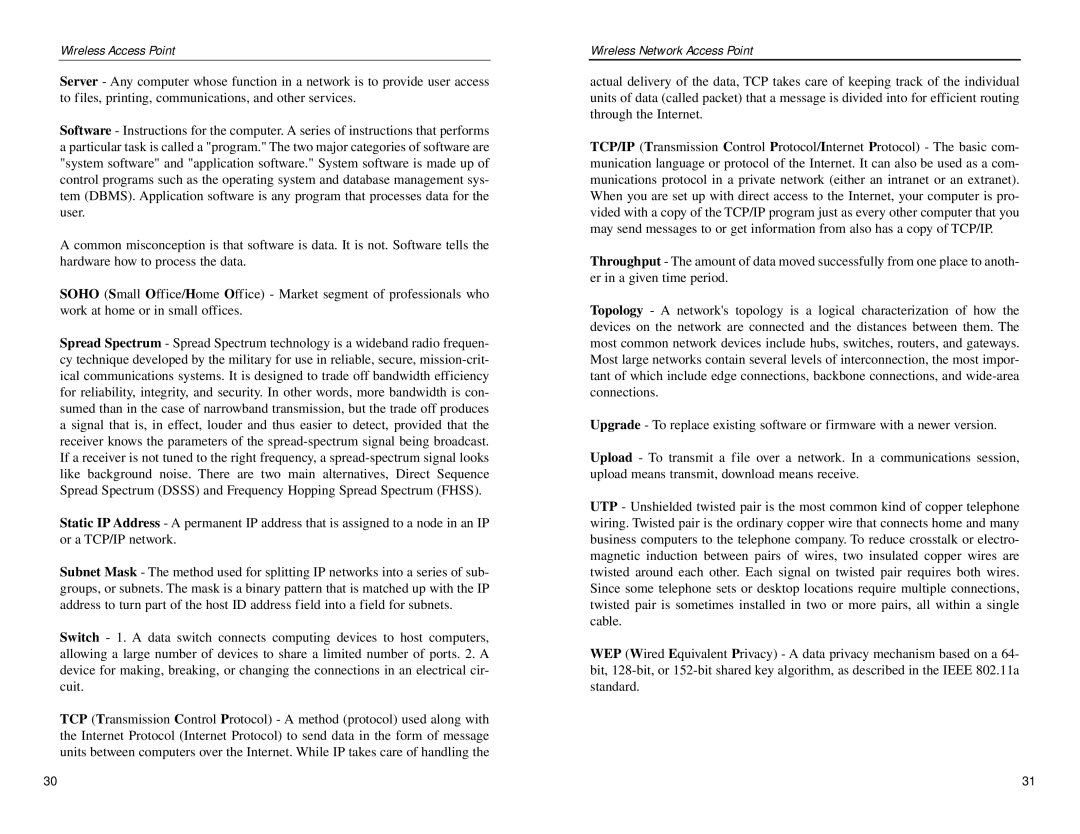Wireless Access Point
Server - Any computer whose function in a network is to provide user access to files, printing, communications, and other services.
Software - Instructions for the computer. A series of instructions that performs a particular task is called a "program." The two major categories of software are "system software" and "application software." System software is made up of control programs such as the operating system and database management sys- tem (DBMS). Application software is any program that processes data for the user.
A common misconception is that software is data. It is not. Software tells the hardware how to process the data.
SOHO (Small Office/Home Office) - Market segment of professionals who work at home or in small offices.
Spread Spectrum - Spread Spectrum technology is a wideband radio frequen- cy technique developed by the military for use in reliable, secure,
Static IP Address - A permanent IP address that is assigned to a node in an IP or a TCP/IP network.
Subnet Mask - The method used for splitting IP networks into a series of sub- groups, or subnets. The mask is a binary pattern that is matched up with the IP address to turn part of the host ID address field into a field for subnets.
Switch - 1. A data switch connects computing devices to host computers, allowing a large number of devices to share a limited number of ports. 2. A device for making, breaking, or changing the connections in an electrical cir- cuit.
TCP (Transmission Control Protocol) - A method (protocol) used along with the Internet Protocol (Internet Protocol) to send data in the form of message units between computers over the Internet. While IP takes care of handling the
Wireless Network Access Point
actual delivery of the data, TCP takes care of keeping track of the individual units of data (called packet) that a message is divided into for efficient routing through the Internet.
TCP/IP (Transmission Control Protocol/Internet Protocol) - The basic com- munication language or protocol of the Internet. It can also be used as a com- munications protocol in a private network (either an intranet or an extranet). When you are set up with direct access to the Internet, your computer is pro- vided with a copy of the TCP/IP program just as every other computer that you may send messages to or get information from also has a copy of TCP/IP.
Throughput - The amount of data moved successfully from one place to anoth- er in a given time period.
Topology - A network's topology is a logical characterization of how the devices on the network are connected and the distances between them. The most common network devices include hubs, switches, routers, and gateways. Most large networks contain several levels of interconnection, the most impor- tant of which include edge connections, backbone connections, and
Upgrade - To replace existing software or firmware with a newer version.
Upload - To transmit a file over a network. In a communications session, upload means transmit, download means receive.
UTP - Unshielded twisted pair is the most common kind of copper telephone wiring. Twisted pair is the ordinary copper wire that connects home and many business computers to the telephone company. To reduce crosstalk or electro- magnetic induction between pairs of wires, two insulated copper wires are twisted around each other. Each signal on twisted pair requires both wires. Since some telephone sets or desktop locations require multiple connections, twisted pair is sometimes installed in two or more pairs, all within a single cable.
WEP (Wired Equivalent Privacy) - A data privacy mechanism based on a 64- bit,
30 | 31 |
